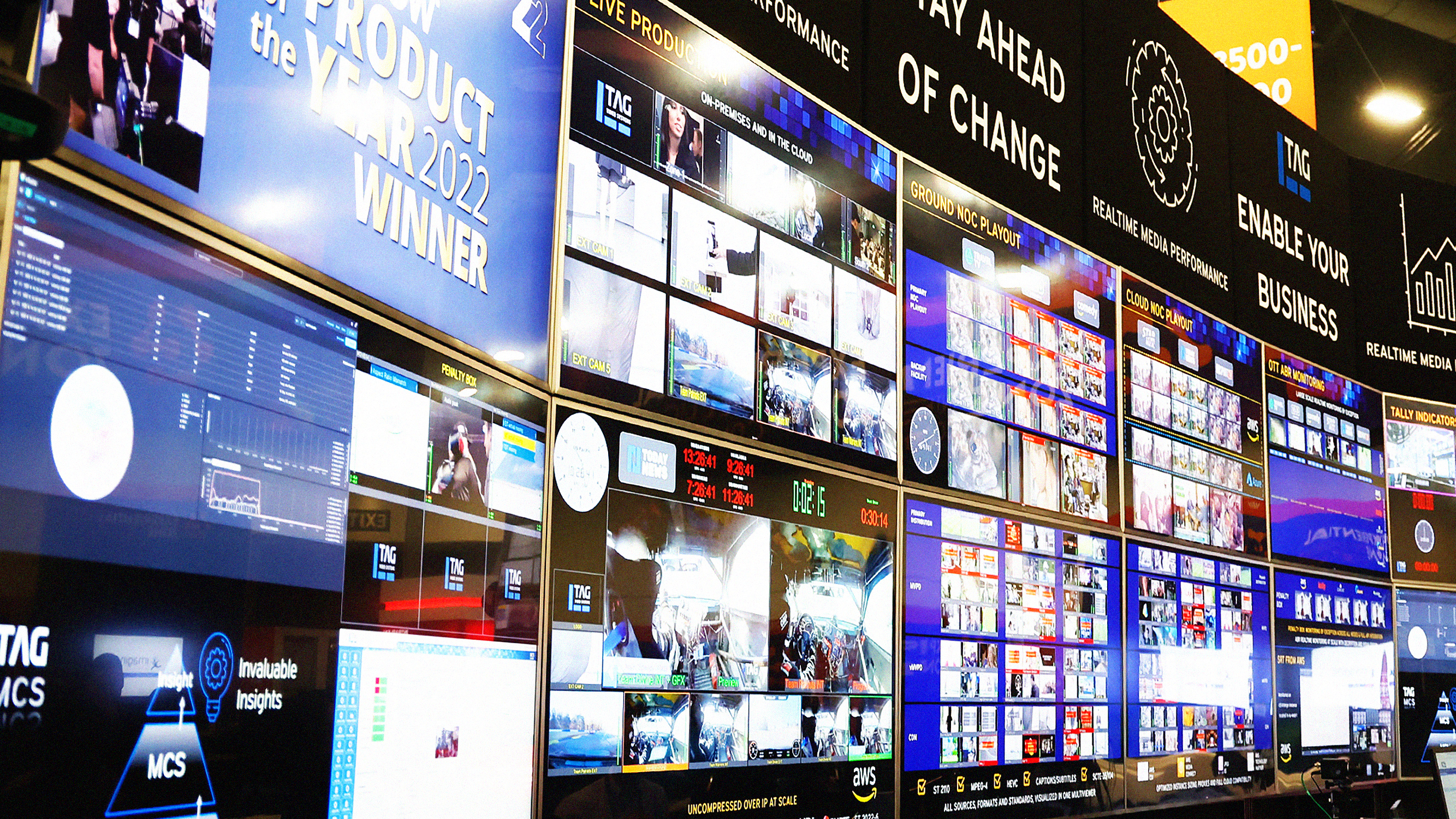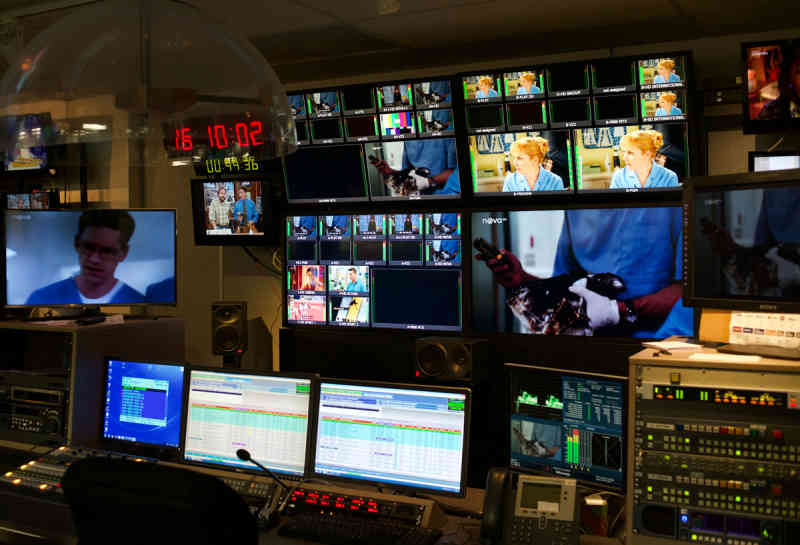
A modern studio facility cannot function without a multiviewer, a device and product function that has come into its own in the past 20 years. Attempting to display today’s plethora of control room signals on individual monitors the old-fashioned way is unthinkable—only a properly configured multiviewer system can handle the task.
Multiviewers and large-screen displays are so economical and flexible that multiviewer technology is now often built into switchers. This makes assembling a simple control room faster than it was in the individual displays.
The twist today is that more signal types than ever are flowing through control rooms, and these disparate signals need to be displayed via the multiviewer system. Live video from cellphones? TikTok feeds? Drone shots? UHD? HDR? Every type of signal using every type of encoding and compression needs to be displayed.

“The requirements to handle these mixed signals are systemic—facilities need to be able to ingest, produce, transform, playout, and monitor signals that might originate in any of these formats,” said John Mailhot, CTO and director of infrastructure product management for Imagine Communications. “We approach this mix of signal types from a system design perspective, using intelligence in the broadcast control system to dynamically allocate transformation paths that conform the selected source to the requirements of the destination. This approach provides the most flexible workflow, as well as the best economics.”
Every Imaginable Signal
In other words, making every multiviewer input capable of handling every imaginable type of signal gets unwieldy and expensive. There is a better way.
In anticipation of this growing trend towards mixed-format environments, Lawo’s HOME Multiviewer natively supports SMPTE ST2110, NDI, SRT, JPEG XS, H.265 and H.264, according to John Carter, senior product manager for media infrastructure at Lawo.
“Currently, each instance handles one of these formats,” he said. “For mixed sources and destinations involving ST2110, NDI and SRT streams, users have the option of inserting a HOME Stream Transcoder app before the Multiviewer to convert, say, SRT streams to ST2110 if this is the desirable format for a multiviewer head. This transcoding flexibility works in all directions and for all formats supported by the HOME Multiviewer app.”

Some multiviewer solutions leverage cloud computing to lower in-house energy and space demands.
“Evertz ev670-X30 hardware provides high-density signal monitoring for up to 64 3G ST2110 inputs with full audio, ancillary data and video monitoring. This uses less RU space, less power and less cooling,” said Ketan Patel, product manager for multiview systems at Evertz.
“Evertz also provides a COTS-based sVIP product that allows compressed and uncompressed signal monitoring at high density, which can be deployed on an x86 platform with an accelerated PCI card. Evertz also offers cVIP, which is a cloud-based monitoring and visualization product that can be deployed in any public or private cloud, to allow signal monitoring of NDI, MPEG-2, H.264, H.265 and JPEG2000.”
What if There’s an Error?
A multiviewer system is, by necessity, filled with a variety of images, most of which are in some state of motion. With all that on-screen activity, it can be easy to miss if one of the signals disappears or gets scrambled in some fashion.
Cobalt Digital has multiviewer options that help you keep track of dropouts, errors and loss-of-signal, said Ciro Noronha, CTO of Cobalt Digital. Noronha added that the company’s multiviewers can be configured with a range of options that include text overlays for arbitrary text, timecode, signal resolution, and even closed captioning. The systems can also add audio bars, a built-in router to simplify configuration, flexible inputs that can mix-and-match resolutions and frame rates, and tally insertion to indicate on-air signals or other status information.

“Cobalt’s baseband multiviewers are offered in the openGear form factor, so that they can be easily integrated with other devices in the same chassis, and benefit from the inherent openGear features such as hot-swappable cards, dual redundant hot-swappable power supplies, and the DashBoard control system,” Noronha said. “This flexibility is very important, since it allows the multiviewer to adapt to virtually any requirement.”
At the IBC Show next month, Cobalt will introduce its Ultra Blue multiviewer, with support for the more common compressed formats, with plans to add SMPTE ST 2110 inputs as well as other formats such as NDI in the future.
TAG Video Systems IP-based multiviewer line can be deployed with either a private or public cloud provider, such as AWS or Google Cloud. Through its RESTful API, the TAG Realtime Media Performance platform can be automated and integrated with third-party solutions and software-defined networking (SDN) controllers.
Only Pay for What You Need
With a cloud architecture, you can have nearly unlimited inputs. So how do you get only what you need?
“You only pay for input licenses and have full access to all the product’s monitoring, probing, and display features,” said Robert Erickson, vice president for live production & sports at TAG Video Systems. “This means you can use any supported signal feed, resolution, compression, or transport format without worrying about paying for additional feature sets.”
Which raises the point: Should you consider a hardware-based multiviewer or software-based system? A lot depends on the complexity of your control room and the signals you deal with. A big-city broadcaster or a large sports arena will
have different needs than a cable distribution center.
Manufacturers have their own ideas.
“Modern multiviewers should firstly be software-based to provide running in any environment,” said Eric Otto, CEO of Mediaproxy. “They should also provide support for all common broadcast source formats, including access to remote sources (IP, TSoIP, NDI, HLS) as well as local sources (SDI, ST 2110).”
Scaling in Size
If you run a smaller system, you don’t have the needs of a big arena, and there are solutions that make sense for your needs.

“Our Smart Display Module multiviewers use a small board that slots directly into an SDM-capable display,” said Thomas Tang, president of Apantac. “These SDM boards turn a standard display into a monitor with an embedded multiviewer.”
SDM is an Intel standard, and it can support SDI, 12G SDI, NDI and other video formats.
Apantac makes a range of multiviewers from small to large. At the top of the line is the T# system. “The T# is our flagship multiviewer line, which supports up to 128 inputs and 16 outputs, as well as supporting many different input formats that can be mixed and matched in the same frame,” Tang said. “These formats include 12G, 3G, HD, SD-SDI, CVBS, HDMI 1.4, HDMI 2.0, H.264, and most recently NDI. Customers can freely mix and match with the formats they need, and any inputs can go to any outputs.”
Multiviewers are clearly the better way of monitoring video in control rooms. The benefits of multiviewers were so obvious and powerful that some big old-line manufacturers of video monitors rapidly disappeared from the industry. Anyone remember Conrac?
There are multiviewer solutions out there for any size and need, so plan what you need carefully. Of course, the display you choose is an important part of the multiviewer system, so plan to get one that works properly with your system.







